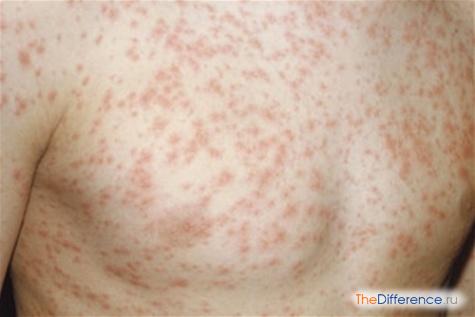Chickenpox and measles have a number of common characteristics. The diseases are united by their viral nature, the presence of fever and rash as symptoms, and the fact that each of them can affect a person, as a rule, only once. But if chickenpox usually passes without a trace, then measles in some cases can be very insidious and even life-threatening. To choose the right treatment and save yourself from the risk of complications, you need to know the difference between chickenpox and measles.
General information
Each of these diseases is easy to become infected if the body comes into contact with the pathogen for the first time. The second time, in the absence of exceptional factors, it is impossible to catch the disease because the body manages to develop stable immunity during the period of fighting the disease.
What viruses cause the diseases in question? Relatively chickenpox This is varicella zoster. The same pathogen can infect a person with another illness that is clinically not similar to chickenpox - herpes zoster.
Chickenpox
Concerning measles, then infection occurs after a pathogen from the paramyxovirus family enters the body.
 Measles
Measles Comparison
Comparing the incubation period of diseases, it should be noted that for chickenpox it can last longer – up to three weeks. For measles, this period of time usually does not exceed two weeks. The first manifestations of each disease are also different. The only thing that will be common is that the patient begins to have a fever, and with measles the temperature can rise higher.
The rash in both cases acts as an obligatory symptom. But an important difference between chickenpox and measles is when the rash appears. With chickenpox, they are detected on the skin already at the initial stage, simultaneously with fever. With measles, a rash is not one of the first symptoms. At least three or even five days pass from the onset of the disease before it occurs.
The first blow in the case of measles falls on the mucous membranes. This is expressed in inflammation of the conjunctiva, the appearance of photophobia, runny nose and sneezing, hoarseness, and cough. The senses of smell and taste are dulled. In the mouth, on the mucous membrane of the cheeks, spots with a light center and red edges are found.
Later the skin becomes covered with a rash. Moreover, if chickenpox spreads throughout the body chaotically, then measles rash affects areas of the skin in a certain sequence. Starting from the face, areas behind the ears, and neck, it moves lower and lower, capturing the torso, flexure points on the arms and legs, and fingers.
When considering the difference between chickenpox and measles, we should dwell in more detail on the nature of the rash and its changes during the course of the disease. So, with chickenpox, watery swellings are found, which then dry out. The crusts that appear soon disappear.
Skin formations during measles are represented by papules against a background of spots. Fragments of the rash tend to merge. The affected areas peel off as they heal. In the places where the rash was, pigmentation lasts for up to one and a half weeks.


